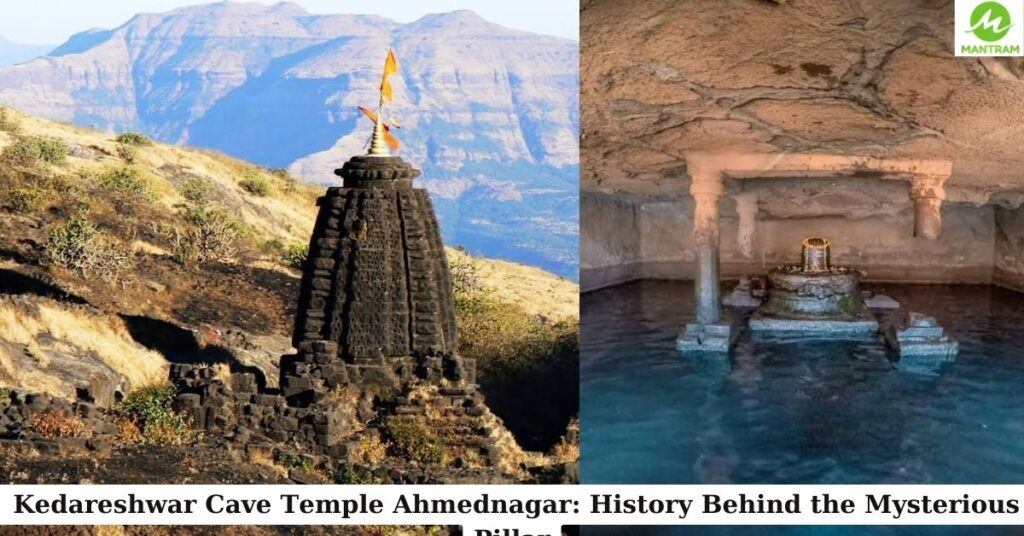Nestled amidst the rugged beauty of Harishchandragad Located in Malshej Ghat in Ahmednagar district, the Kedareshwar Cave Temple is a testament to architectural splendor and spiritual significance. This ancient temple holds within its precincts a mysterious pillar, shrouded in legends and mysteries that have intrigued generations.
A Glimpse of Harishchandragad:
Harishchandragad, a hill fort situated in the Ahmednagar district of Maharashtra, is renowned for its historical and natural charm. Perched at an elevation of around 4,671 feet, this site has been a beacon for trekkers, history enthusiasts, and devotees seeking a divine connection.
The Kedareshwar Temple’s Unique Aura:

Within the embrace of Harishchandragad’s craggy landscape lies the Kedareshwar Temple, a sacred abode with a unique aura. This temple, dedicated to Lord Shiva, is a marvel of ancient architecture, showcasing intricate carvings and detailed craftsmanship.
The sanctum sanctorum of the Kedareshwar Temple houses an awe-inspiring idol of Lord Shiva. The deity, depicted in his serene and meditative form, exudes an air of mysticism and tranquility. Devotees are drawn to the divine presence, seeking solace and blessings amidst the rugged surroundings.
Kedareshwar Temple Location:
Reaching the Kedareshwar Temple requires a trekking expedition that adds to the allure of the experience. The journey involves navigating through rocky terrains and verdant landscapes, providing adventurers with a sense of accomplishment and communion with nature.
As the temple is perched atop Harishchandragad, the panoramic views from its vicinity are simply breathtaking.
Kedareshwar Temple History
According to the locals, the temple was built by the Kalachuri dynasty built this fort back in the 6th century, but the Harishchandragad fort caverns were dug out in the 11th century.
The great sage Changdev stayed at the fort and spend his time with meditation in the temple and also wrote the famous scripture “Tatvasaar” in the 14th century. the fort was under the control of mughals in the 16th century and in the 18th century mighty Maharashtra.
Mangal Ganga holy river stated that this river originated from the water tank surrounded by the temple. The Saptatirtha Pushkarni meaning Seven Waters is by the eastern side of the temple known for its healing properties.
Architectural Style of Kedareshwar Cave Temple
The architecture of the temple is Hemadpanti style and is dedicated to Harishchandreshwar.
The architecture of the Kedareshwar Temple, situated on the picturesque Harishchandragad in Ahmedabad, is a fascinating fusion of ancient craftsmanship and religious symbolism.
This temple stands as a testament to the artistic and architectural brilliance of the era in which it was built, showcasing a unique blend of form and function.
There are three caves close to the temple. the most mysterious temple is Kedareshwar temple which is located to the right of the temple. This beautiful cave has 5 feet Shivling sitting in the middle of the ice-cold water.
There are spiritual scriptures carved out in the cave. this temple is inaccessible during monsoon because of the water flow around the temple.
The Kedareshwar Temple follows the traditional architectural style that is characteristic of many ancient Hindu temples. Its design adheres to the principles outlined in ancient Indian architectural treatises, which emphasize harmony, proportion, and symbolism.
The temple’s layout, orientation, and intricate detailing reflect the deep-rooted cultural and spiritual values of the time.

Entrance and Facade:
Central Sanctum:
The heart of the temple lies in its central sanctum, where the idol of Lord Shiva resides. The sanctum is typically square or rectangular in shape, and its design creates a sense of reverence and focus. The idol of Lord Shiva is often placed in a meditative posture, exuding an aura of tranquility and divinity.
Pillared Halls and Mandapas:
Surrounding the central sanctum, the temple often features pillared halls and mandapas (open pavilions).
The Four Pillars.
These pillars hold within them a story that echoes through the ages, blending mythology, spirituality, and the mysteries of the divine.
The Symbolism:
The Four Pillars of the Kedareshwar Temple are not merely structural elements; they carry deep symbolism in Hindu mythology. Each pillar represents one of the four Yugas, or cosmic ages, as per Hindu cosmology.
These Yugas—Satya Yuga, Treta Yuga, Dvapara Yuga, and Kali Yuga—symbolize different phases in the cyclic nature of creation and existence.
The Mythical Connection:
According to local legends, the Four Pillars are said to symbolize the steadfast devotion of Lord Brahma, the creator deity, to Lord Shiva. It is believed that Brahma performed penance at this very spot, offering prayers and meditation to Shiva, seeking blessings and guidance. The pillars serve as a reminder of this divine connection and the eternal cycle of creation, preservation, and dissolution.
The Changing Heights:
Adding to the intrigue, these pillars are said to change their heights in response to the changing Yugas. As each cosmic age progresses, the height of the corresponding pillar is said to alter, signifying the shifts in the cosmic order and the transition from one Yuga to another. This mystical phenomenon is believed to be a direct manifestation of divine energy and intervention.
And one of the Mysterious facts is also that the water surrounding Shivling changes its temperance during winter and summer. During winter it turns into luke hot water and during summer into ice cold.
Modern Interpretation:
While the legends surrounding the Four Pillars may vary, the essence remains consistent—a celebration of divine connection, cosmic cycles, and the eternal truths of existence. Today, visitors to the Kedareshwar Temple witness not just physical pillars but also the embodiment of a timeless narrative that resonates with the spiritual seekers and history enthusiasts who cross its threshold.
The enigmatic aspect of the Four Pillars arises from the belief that their heights change over time, corresponding to the progression of the cosmic Yugas. This phenomenon, though a matter of deep reverence for many, has also sparked controversy and debate within both religious and scientific communities.

The pillar is to believed to break off by the end of each yuga, and till now four of the three pillars were broken it is to be said that the fourth one is the Kal yuga and when it’s gonna finish this fourth pillar is related to it.
Some skeptics argue that the perceived change in pillar heights may be a result of geological shifts or natural erosion rather than a divine phenomenon. This controversy has led to contrasting interpretations of the temple’s mystical aspects, adding layers of complexity to its narrative.
Spiritual Significance:
Irrespective of the controversy, the Four Pillars of the Kedareshwar Temple remain an integral part of its spiritual landscape. They invite visitors to reflect on the cyclical nature of existence and the passage of time, emphasizing the importance of devotion and cosmic awareness in the journey of life.
The Four Pillars of the Kedareshwar Temple hold a mirror to the eternal dance of time and the unending cycle of creation and destruction. They remind devotees of the impermanence of worldly existence and the transcendence of the divine. The changing heights of the pillars symbolize the eternal flow of cosmic energies and the perpetual rhythm of existence.
How to Reach Kedareshwar Cave Temple
Reaching the Kedareshwar Cave Temple on Harishchandragad via bus and train is a two-step journey that combines both modes of transportation. Here’s a guide on how to reach the temple using these options:
Step 1: Reach the Base Village
By Bus:
Start your journey by taking a bus to the nearest town or village that serves as the base point for the Harishchandragad trek. The base village is typically Ahmednagar or a nearby village like Khireshwar.
You can find regular bus services from major cities and towns to Ahmednagar. Check the bus schedule and availability beforehand.
Once you reach Ahmednagar, inquire about buses or local transportation to Khireshwar or the designated base village for the Harishchandragad trek.
The base village will serve as the starting point for your trek to the Kedareshwar Cave Temple.
By Train:
Take a train to Ahmednagar Railway Station, which is well-connected to major cities in Maharashtra and neighboring states.
From the railway station, you can hire a taxi, or auto-rickshaw, or use local bus services to reach the base village of Harishchandragad trek, like Khireshwar.
Make sure to check train schedules and availability in advance.
Step 2: Trek to Kedareshwar Cave Temple
Trekking Route:
Once you’ve reached the base village, start your trek towards Harishchandragad hill fort.
Follow the well-marked trekking trail that leads to the Kedareshwar Cave Temple. The trek can take a few hours, depending on your pace.
Ensure you have proper trekking gear, comfortable shoes, water, snacks, and any necessary supplies.
Exploring the Temple:
Upon reaching the Kedareshwar Cave Temple, explore its architectural marvels, soak in the spiritual atmosphere, and pay your respects to the deity.
Enjoy the panoramic views and natural beauty from the temple premises.
Return Journey:
After spending time at the temple, descend back to the base village.
From the base village, you can retrace your steps to the town or village where you began your journey.
If you arrived by train or bus, arrange transportation back to the respective train station or bus stop.
Essentials:
Carry essentials like water, snacks, first aid kit, appropriate clothing, sun protection, and trekking gear.
Inform someone about your travel plans and estimated return time for safety.
Conclusion:
The story of the Four Pillars at the Kedareshwar Temple is a tale of devotion, cosmic symbolism, and the profound mysteries of the universe. As you stand before these pillars, you’re not just witnessing an architectural marvel; you’re connecting with a narrative that transcends time, inviting you to contemplate the profound truths that lie at the intersection of mythology and spirituality.



